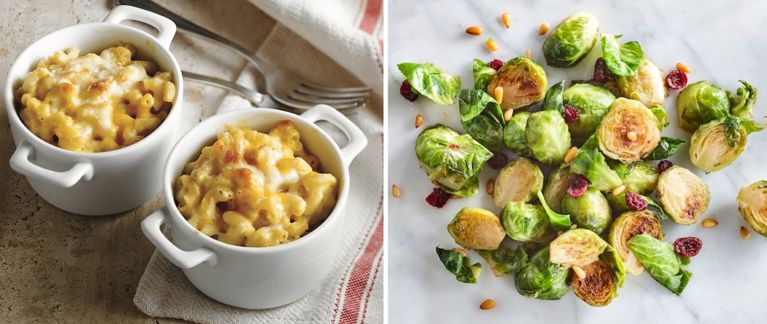Maple: Not Just For Breakfast

Maple is one of our nation’s favourite flavours—not surprising, as maple syrup is one of Canada’s greatest exports, made largely by 13,300 maple producers in Quebec. But many of us have not ventured beyond adding that deliciously sweet, sticky syrup to our pancake breakfasts or sweet desserts.
Truth be told, maple comes in many forms other than syrup, such as butter, taffy, sugar, flakes, spirits and even water. That means it can be added to any number of recipes, in particular savoury dinner dishes, to add a hint of sweetness but also to enhance and harmonize with other flavours.
Understanding maple syrup colours and flavours
Even if you’re sticking to maple syrup (pardon the pun!), there are four distinct colours to consider: golden, amber, dark and very dark. These hues indicate the life-cycle stage of the sap, from early harvesting to late, and affect the flavour of the maple syrups.
Golden maple syrup means delicate taste. Drizzle onto a salad, some yogurt or a bowl of ice cream, or use in a sauce or dressing as a light marinade. Amber maple syrup means rich taste.
Most commonly used for flapjacks and waffles, amber syrup has a pure, rich flavour that goes well in baking as well as in vinaigrettes and glazes and with roasted veggies and seafood. Dark maple syrup means robust taste—a deep, but not overpowering, caramelized flavour. It’s ideal for cooking and baking, especially for fruit recipes like crisps, crumbles and pies. Very dark maple syrup means a strong, distinctive taste because it’s harvested at the end of the sugar season. It yields the most intense flavour, with a rich dark colour to match, that’s perfect for adding extra pop to glazes and sauces.

Get cooking with maple
Now that you know the different maple syrup colours and flavours, start adding them to your meals. Turn a boring mac and cheese into a mouth-watering delight using this Maple & Butternut Squash Mac 'N Cheese recipe, which is ideal for incorporating dark maple syrup. Or jazz up your next homemade pizza night with this recipe for Maple Arugula Pizza, which uses maple vinegar—easily make your own with amber maple syrup and cider vinegar. If you need a side dish, you can’t go wrong with this crowd-pleaser: Maple Roasted Brussels Sprouts with Dried Cranberries and Pine Nuts. Maple is a delicious way to add extra caramelization to roasted veggies and bring out their natural sweetness. And adding maple to any root vegetable packs a sweet punch, whether you sprinkle over squash or work into your mashed sweet potatoes.

There is no better ingredient for caramelization than maple syrup, and all maple products can be used as a natural sweetening agent. Substituting maple to sweeten can add a balance and nuance to your recipes, making old dishes new again.
So go ahead and flex your creative cooking muscle by grating maple sugar over dessert or fish/poultry, whisking maple syrup into whipped or even sour cream, or simmering or poaching foods in maple water. Or simply put a bottle of Canadian maple syrup on the table at your next dinner party and let your guests garnish as they see fit. Nearly everything tastes better with maple.
Get more maple-inspired recipes and other cooking ideas at Maple from Canada.
Want to see the Maple & Butternut Squash Mac 'N Cheese recipe come to life? Take a quick look at how easy it is—your family and friends will love it!
